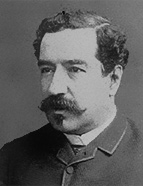

Librarian, archivist, bibliophile, historian, patrimonialist, publicist, and writer Gabriel Pereira was born in Évora, on 7 March 1847, on the old Rua da Ladeira (which today bears his name) in the civil parish of Santo Antão. He passed away in Lisbon on 6 December 1911. He was the son of António Pereira da Silva, a teacher at Liceu de Évora [Évora High School], and Luísa do Monte Pereira, who came from an old farming family of Évora. G. Pereira completed his primary and secondary education in Évora before enrolling in the Escola Naval [Naval School] in Lisbon, which he later left due to family reasons. He subsequently enrolled at the Escola Politécnica [Polytechnic School] in the same city. However, he did not complete his degree and, although he chose not to pursue studies in the Humanities, he studied palaeography at the Torre do Tombo.
In the capital, he often visited the home of Manuel Maria Bordalo Pinheiro and became acquainted with his children, including Rafael Bordalo Pinheiro. He developed connections with other notable figures in the Arts and Humanities circles, including Pedro W. de Brito Aranha, Gomes de Brito, and António Enes. Together, with whom he established an informal literary and artistic academy, which met periodically at Lisbon's Praça da Alegria and in R. Bordalo Pinheiro's studio, located in the old Largo da Abegoaria.
After completing his archival training, G. Pereira travelled to Setúbal to take up a teaching position at the Liceu managed by his father. Here, he dedicated himself to historical and archaeological studies, foreshadowing his later intellectual production. However, when the Liceu was closed, he returned to Évora where, in 1872, encouraged by Augusto Filipe Simões — to whom he dedicated one of his earliest works (1875) — he took up a position as a clerk in the secretariat of the Santa Casa da Misericórdia, organising and preserving its historical archive for 14 years. This work enabled him to uncover documents concerning lost property, thereby boosting the organisation's income.
This work is financed by national funds through FCT - Foundation for Science and Technology, I.P, in the scope of the projects UIDB/04311/2020 and UIDP/04311/2020.
